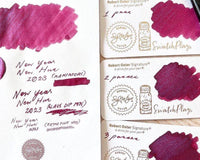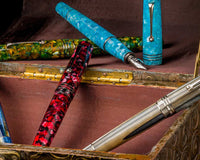For many of us, fountain pens are a staple in our everyday routines. No matter what type of fountain pen we have, we write with it freely, often without considering the long history that led to the modern writing instruments we use today. You may or may not have thought about the name of the pen itself: “fountain pen.” Why is it called as such in the first place? Why do we go around calling these writing tools “fountain pens?” Here, we’ll answer just that and explain the history that led to this writing instrument’s name.
Why do we call it a fountain pen?

Let us answer the question directly — why is it called a fountain pen? The word “fountain” itself comes from the Latin word “fons” and its possessive case “fontana.” It refers to a source of water from within a reservoir.
As we know, fountain pens pull water-based ink from a reservoir in the barrel through the feed and down to the nib. Thus, it made sense to call such a pen a fountain pen.
A brief history and the development of the fountain pen
Fountain pens didn’t always have built-in reservoirs. It took many, many years before modern fountain pens as we know them today came to be.
The history of fountain pens is a long and complex one. Before pens with built-in reservoirs, the world relied on writing instruments that had to be dipped in an inkwell as they did not have ink stored within the pen. This practice was quite inconvenient since writers had to carry both their pens and the inkwell with them everywhere they went. This was not suitable for business dealings or transactions.
However, if we go back in history, we will discover that attempts to fill writing tools with ink date back to before the pen and inkwell became popular. Case in point, the Ancient Egyptians used a reed pen with ink made from vegetable gum and soot to write on papyrus. The pen was filled with the writing fluid and then squeezed to make the ink flow to the tip.
One of the very first accounts of a pen with an ink reservoir was also recorded in 973. It is said that the caliph Ma'ād al-Mu'izz of Maghreb in North Africa grew tired of getting his hands dirty when using standard dip pens. He requested a pen that would keep his hands clean, and his wish was granted with a pen that already contained ink inside.

A few centuries later the quill pen was introduced in Spain, made from swan, goose, or turkey feathers. When the pen was dipped in ink, the hollow feather shaft acted as a reservoir. This type of pen was used for many centuries.
In 1636, a new iteration of the fountain pen was created. German inventor Daniel Schwenter innovated the existing dip pen by placing one quill inside another to form an ink reservoir. And in 1822, John Mitchell from England manufactured dip pens with steel nibs, making writing instruments more accessible, resulting in a positive effect on literacy and education during the time.

It was during this time that the fountain pen was starting to become more like the modern ones we know and love today. Just five years after John Mitchell’s innovation, Petrache Poenaru created something similar to Daniel Schwenter. He used a swan’s quill as the barrel of the pen. However, these designs were not refined and were prone to leaking and other issues with ink flow.

It was during this time that patents were being created one after the other for different versions of fountain pens. In the 1850s, the stylographic pen was created, which used a wire tube for an ink valve. In 1884, Lewis Edson Waterman created a fountain pen with a feed that enabled a more consistent ink flow. And by the early 1900s, many pens were self-filling, using soft rubber sacs.
The bottom line
The history behind why the fountain pen is called a fountain pen is more complex and colorful than we realize. Though the list of inventors on this list is by no means exhaustive, the individuals we highlighted and their contributions show just why the name “fountain pen” is such a perfect representation of the writing tool we know and love. It came from an outpouring of desire to merge pen and ink together and make writing easier and accessible to all. And that is something we continue to share with others as we spread the fountain pen hobby today.
Written by EndlessPens Blogger Ramona Kabigting







